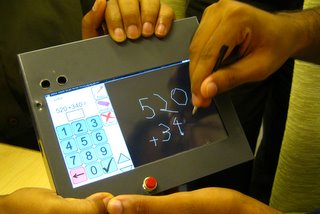S'pore campus-made slate to focus on usability

SINGAPORE--A local joint research institute at Nanyang Technological University is developing a solar-powered electronic slate targeted at rural villages called the I-slate, where usability will be an important feature for the tablet, says a researcher.
In a Thursday interview with ZDNet Asia, Vincent Mooney, visiting associate professor and senior fellow at Nanyang Technological University (NTU) School of Electrical and Electronic Engineering, said the user experience has always been a "big question" for computer science, and the same applies to the slate.

Prototype I-slate
Still in its prototype stage, the I-slate is a device developed by Singapore-based Institute of Sustainable and Applied Infodynamics (ISAID), a joint research institute by NTU and Houston-based Rice University. Mooney, who is credited as the institute's chief I-slate hardware architect, noted that the product is targeted to be finalized in a year's time.
Unlike the general-purpose computer in the One Laptop per Child (OLPC) project, the I-slate is being conceived as an ultra-low-powered embedded system that is charged by solar energy. Mooney explained that an embedded system is a machine that performs fixed functions, which for the I-slate is education.
User feedback is critical when designing an embedded system, said Mooney who noted that unlike a general-purpose computer, an embedded system cannot be changed once it is focused on an application.
Another differentiator for the I-slate is its ability to run on solar power. According to Mooney, many rural villages lack reliable power grids, which make charging a battery-powered device problematic. On the side, one of the research fellows told ZDNet Asia that the finalized I-slate is estimated to hold 3.5 hours of power after being charged under the sun.
According to Mooney, a challenge for the I-slate was in deciding the tradeoff between functionality and being powered only by solar cells. "The tradeoff is you can't do Microsoft Word...but [with the I-slate] you can still reach the targeted community without a full-function software set," he added.
Mooney noted that the team is currently looking at state government and non-profit organizations as potential partners to launch the product with. However, the institute is not against tying up with for-profit organizations, he added.
"There's a chicken-and-egg problem--before you can convince someone to invest in a new technology, they want to see a prototype and also user feedback," he said.
Mooney said the team hopes to have the I-slate replace chalkboard slates currently used by students in the rural villages, as the electronic version can offer interactivity, instant feedback, and hints for students to aid them in their self-study.
He also added that in the long run, the group aims to release software development kits (SDKs) for the slate so schools can develop their own applications for the system.
The I-slate team will be returning to India next week for a second round of usability testing to trial the software prototype, said Mooney. Eleven prototypes will be distributed to a class of 22 Standard 5 students to practice new math concepts on as taught by their teacher.
The first round of user feedback to test the hardware prototype was completed in August. ISAID is partnering with Hyderabad-based non-profit ViDAL (Villages for Development and Learning Foundation) to test the prototype I-slates.